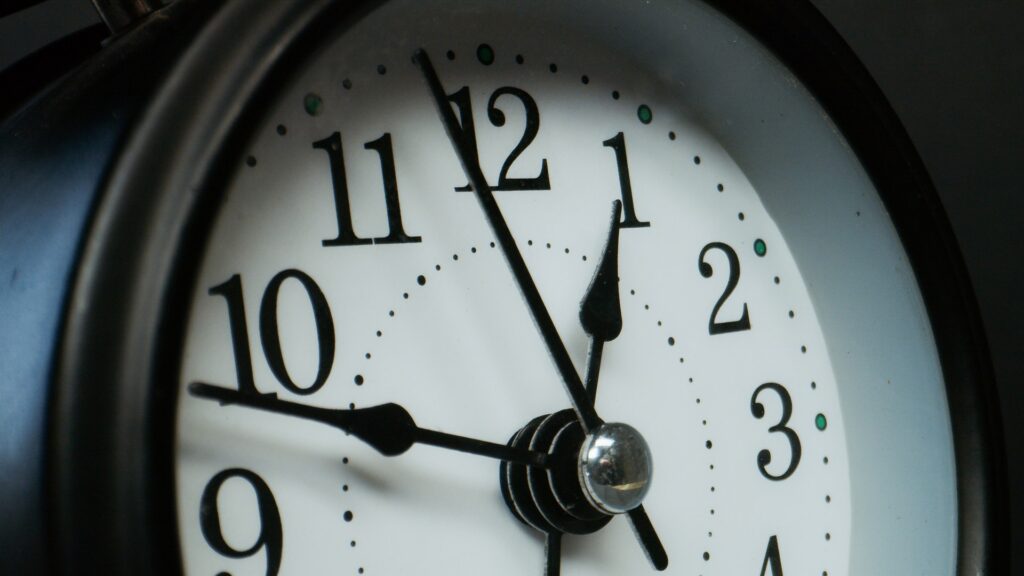In this post we’ll look at how to structure a time phrase in Chinese.
Table of Contents
Simple Time Phrases in Chinese
The basic structure of a time phrase in Chinese is:
subject + time + verb phrase
Example Chinese time phrase sentences
Here are some examples of time phrases following the subject + time + verb phrase sentence pattern for time phrases in Chinese:
Time Phrase Example 1:
I have to go to work tomorrow
| Subject | Time | Verb Phrase |
|---|---|---|
|
I |
tomorrow |
have to go to work |
| Chinese | English |
|---|---|
|
|
I |
|
|
tomorrow |
|
|
go |
|
|
go to work |
Time Phrase Example 2:
He returned home yesterday
| Subject | Time | Verb Phrase |
|---|---|---|
|
He |
yesterday |
returned home |
| Chinese | English |
|---|---|
|
|
he |
|
|
yesterday |
|
|
returned home |
|
|
<past tense> |
Time Phrase Example 3:
“Today they bought a new car”
| Subject | Time | Verb Phrase |
|---|---|---|
|
They |
today |
bought (past tense) a new car |
| Chinese | English |
|---|---|
|
|
They |
|
|
today |
|
|
bought (了 makes this past tense) |
|
|
one unit of vehicle (measure word) |
|
|
car |
Time Phrase Example 4:
“I have class on Monday”
| Subject | Time | Verb Phrase |
|---|---|---|
|
I |
Monday |
have class |
| Chinese | English |
|---|---|
|
|
I |
|
|
Monday |
|
|
have |
|
|
class |
Date Order in Chinese
When talking about dates and times in Chinese the order must be stated from largest to smallest time measure. Let’s compare British English, American English and Chinese Date orders as an example:
| Language | Date Order | Example |
|---|---|---|
| British English | Day – Month – Year | 31st January 2020 |
| American English | Month – Day – Year | January 31st 2020 |
| Chinese | Year – Month – Day |
(2020 January 31) |
Chinese Date and Time Vocabulary is below, however for more details please check out our post on How to say Dates in Chinese and How to tell the time in Chinese.
- Yesterday
昨 天 - Today
今 天 - Tomorrow
明 天 - Year
年 - Month
月 - Day
日 - O’Clock
点 钟 - Morning
早 上 - Noon
中 午 - Afternoon
下 午 - Evening
晚 上
Here are some simple Chinese time and date examples
Yesterday at 10am
2021, June 5th
Now let’s try combining the time order with one of our previous time phrase examples “he returned home yesterday”
Time Order Example 1:
He, yesterday at 10am, returned home
| Chinese | English |
|---|---|
|
|
he |
|
|
yesterday |
|
|
morning (AM) |
|
|
10 o’clock |
|
|
returned home |
|
|
<past tense> |

Time + Location Phrases in Chinese
To add a location to a time phase, the location must be added before the verb phrase:
The basic structure of a time + location phrase in Chinese is:
subject + time + location + verb phrase
Example Chinese Time + Location Phrase
Below are some examples of time + location phrases following the subject + time + location + verb phrase sentence pattern:
Time + Location Example 1:
I want to buy something at the local shops tomorrow
| Subject | Time | Location | Verb Phrase |
|---|---|---|---|
|
I |
tomorrow |
at the local shops |
|
| Chinese | English |
|---|---|
|
|
I |
|
|
tomorrow |
|
|
at |
| local | |
|
|
shops |
|
|
want |
|
|
buy |
|
|
some |
|
|
stuff |
Time + Location Example 2:
“They bought a car at the car dealership today”
| Subject | Time | Location | Verb Phrase |
|---|---|---|---|
|
They |
today |
at the car dealership |
bought (past tense) a car |
| Chinese | English |
|---|---|
|
|
I |
|
|
today |
|
|
at |
|
|
car dealership |
|
|
bought (了 makes this past tense) |
|
|
one unit of |
|
|
new car |
Conclusion
Time phrases are quite simple and follow an easy to remember pattern of:
subject + time (+ location) + verb phrase
The best way to remember is to try and incorporate some time (and location) phrases into your daily speech or practice, and not to memorise grammar order and formulas.

